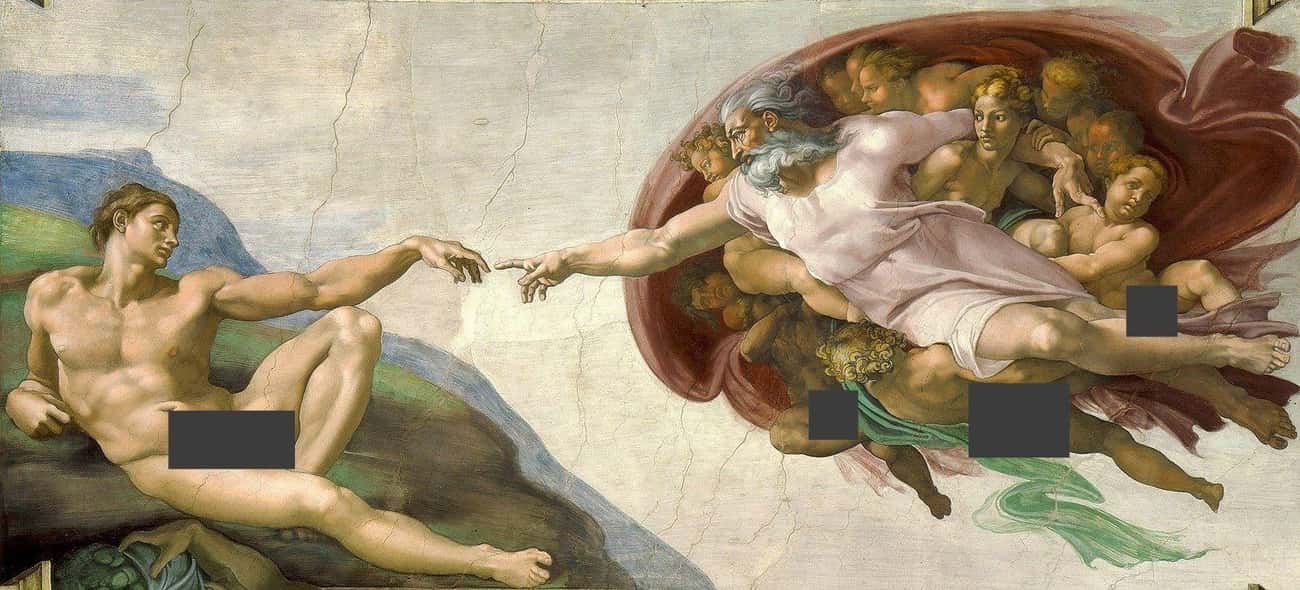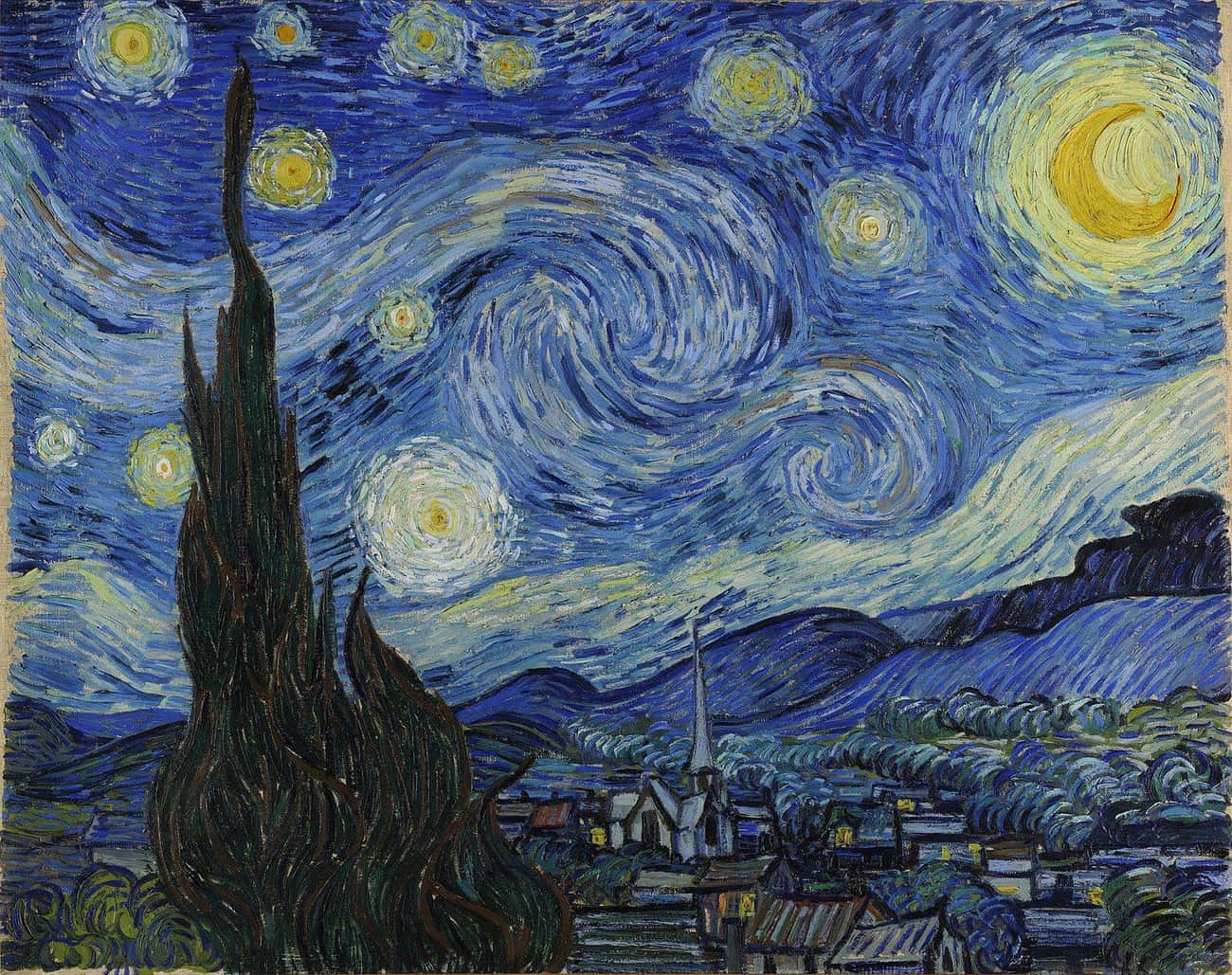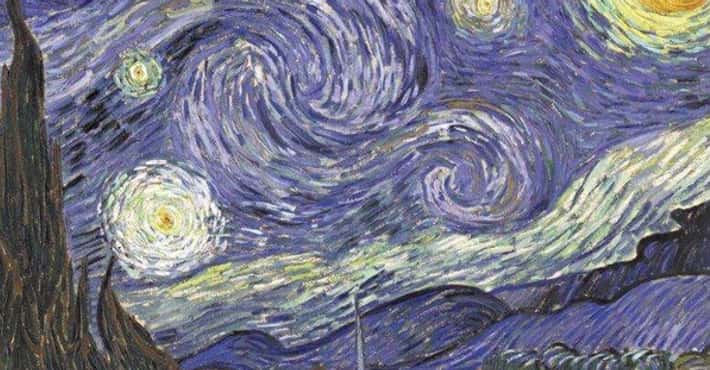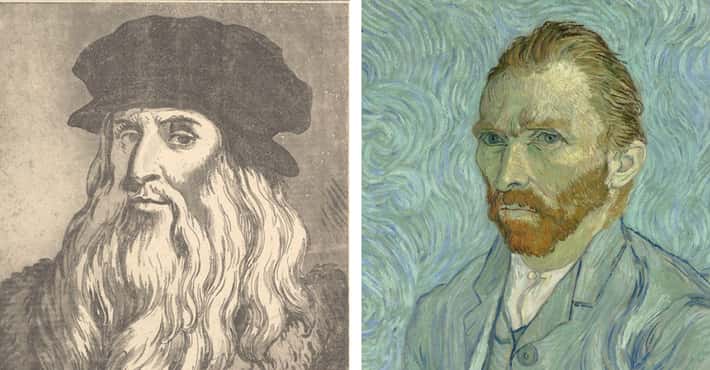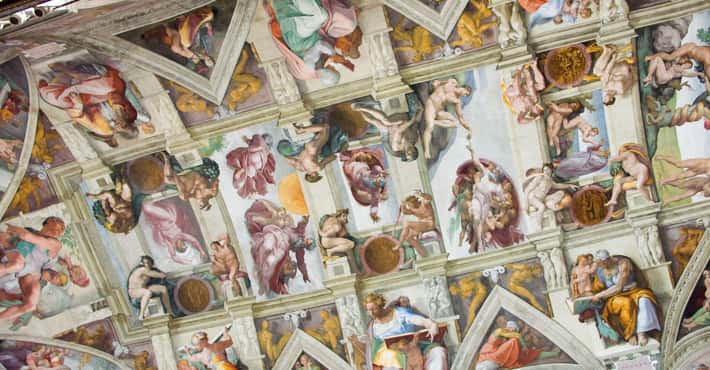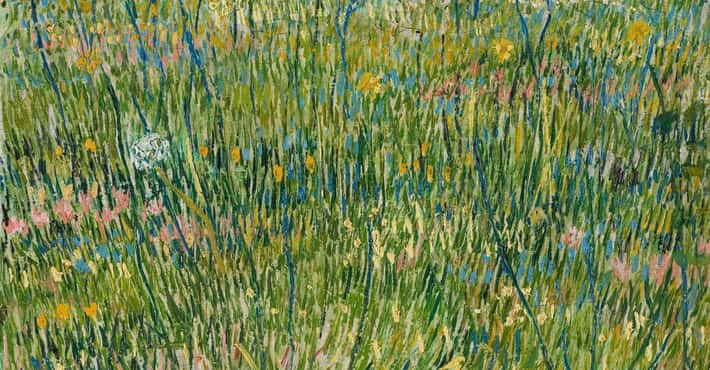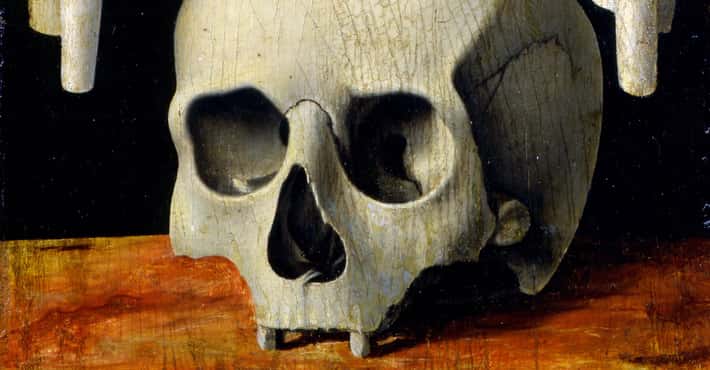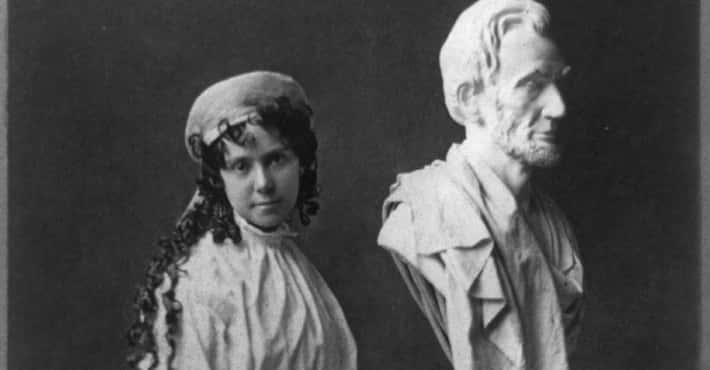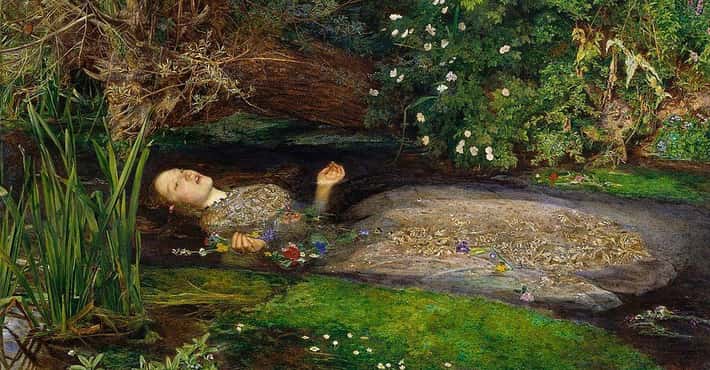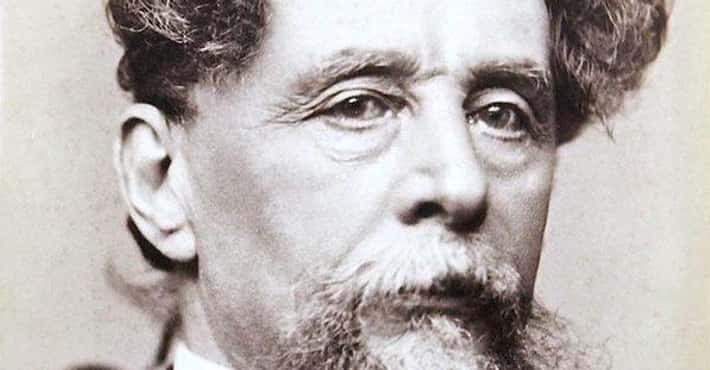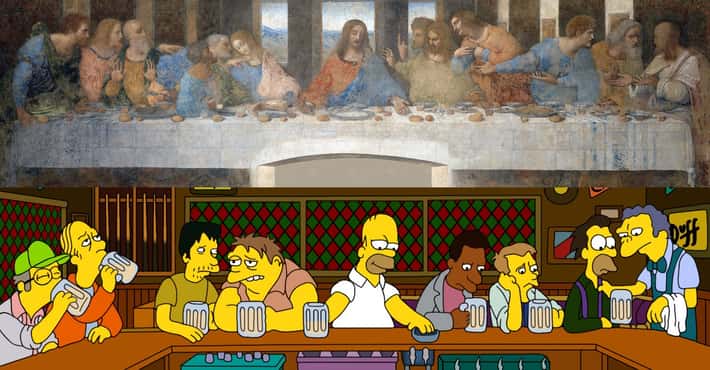The Best Paintings Of All Time
- 13,283 VOTES
- Photo:
- Michelangelo
- Wikimedia Commons
- Public Domain
The Creation of Adam is a quintessential masterpiece by the Renaissance maestro, Michelangelo Buonarroti. Painted between 1508 and 1512, it forms part of the Sistine Chapel's ceiling frescoes in Vatican City, illustrating a biblical moment from the Book of Genesis where God breathes life into the first man, Adam. This iconic work is revered as one of the best paintings of all time, not only for Michelangelo's revolutionary use of anatomical precision and sublime aesthetics but also for the painting's profound embodiment of the humanistic ideals of the Renaissance period. It captures the divine spark of creation with a touch that has become emblematic of the connection between man and the divine, inspiring awe and wonder for generations. The palpable energy and emotion conveyed through the nearly touching hands of God and Adam have cemented The Creation of Adam as a timeless symbol of artistic and spiritual grandeur.
- Photo:
- 24,073 VOTES
- Photo:
- Vincent van Gogh
- Wikimedia Commons
- Public Domain
The Starry Night, painted by the post-impressionist Vincent van Gogh in 1889, stands as one of the most recognizable and celebrated works in art history. Created during his stay at the asylum of Saint-Paul-de-Mausole in Saint-Rémy-de-Provence, van Gogh's masterpiece is an emotional portrayal of the night sky as viewed from his window, characterized by swirling clouds, glowing stars, and a tranquil village beneath. The painting is a testament to Van Gogh's innovative use of color and bold, expressive brushwork that became a hallmark of the post-impressionist movement. It is lauded as one of the best paintings of all time for its powerful combination of beauty, emotion, and its ability to capture the imagination, representing a deeply personal reflection of the artist's psyche and his quest for solace through the act of painting. The ethereal and dreamlike quality of The Starry Night continues to captivate viewers, securing its status as a timeless piece of art that resonates well beyond the era of its creation.
- Photo:
- 32,923 VOTES
- Photo:
- Leonardo da Vinci
- Wikimedia Commons
- Public Domain
The Last Supper, a monumental fresco by Leonardo da Vinci, stands as one of the defining works of the Renaissance period and is widely considered one of the best paintings of all time. Completed in 1498 for the convent of Santa Maria delle Grazie in Milan, it represents the dramatic moment at the Last Supper when Jesus announces that one of his twelve apostles would betray him. Leonardo's mastery is evident in the composition's use of perspective, the arrangement of figures in space, and the emotional intensity and character expressions he captures. The work's innovative approach to grouping the apostles into dynamic clusters and the use of chiaroscuro — the contrast of light and shadow — showcases Leonardo’s profound understanding of human emotion and his skill in conveying narrative through art. The painting's deteriorating condition over time has only amplified its mystical allure and the urgency of preserving this pivotal piece of cultural heritage. Its lasting influence on art, its historical significance for religious narrative, and the technical prowess demonstrated by da Vinci secure The Last Supper's reputation as a masterpiece of Western art.
- Photo:
- 42,969 VOTES
- Photo:
- Johannes Vermeer
- Wikimedia Commons
- Public Domain
Girl with a Pearl Earring is a renowned work by Dutch artist Johannes Vermeer, created circa 1665. This exquisite piece is often referred to as the "Dutch Mona Lisa" and is emblematic of the Baroque period, celebrated for its rich detail and use of light. The painting portrays a young girl, her eyes bathed in a soft, enigmatic gaze, turning over her shoulder to look at the viewer, with a luminescent pearl earring dangling from her ear. It is considered one of the best paintings of all time for its captivating simplicity and the masterful depiction of the girl's delicate features, which have intrigued art enthusiasts for centuries. Vermeer's ability to convey emotion and character through subtle expression and the meticulous rendering of the effects of light on texture give this artwork its timeless allure and its place in the pantheon of great portraiture. Indeed, the mystery surrounding the subject's identity and the mesmerizing quality of her gaze contribute to the painting's enduring fascination and status as a masterpiece of Western art.
- Photo:
- 52,943 VOTES
- Photo:
- Russian Museum
- Wikimedia Commons
- Public Domain
The Ninth Wave, an evocative marine painting by the Russian artist Ivan Aivazovsky, is a luminous showcase of Romanticism and arguably one of the artist's most famous works. Painted in 1850, it depicts a group of shipwreck survivors clinging to a fragment of their broken mast as they are illuminated by the hopeful light of the morning after a tumultuous storm. Aivazovsky's masterful rendering of the sea at its most formidable and majestic—as well as the fragile state of the survivors—captures the power and beauty of nature that Romantic artists often emphasized. The artwork is considered one of the best paintings of all time for its technical brilliance, particularly Aivazovsky's ability to portray the transparency and movement of the waves with such realism that the viewer can almost feel the spray of the sea. Its emotional impact, combined with the painter's profound understanding of light and color, evokes a sense of awe and human vulnerability, leaving a lasting impression on those who view it. Through The Ninth Wave, Aivazovsky solidified his reputation as a preeminent painter of seascapes and his contribution to the Romantic movement.
- Photo:
- 62,377 VOTES
- Photo:
- Sandro Botticelli
- Wikimedia Commons
- Public Domain
The Birth of Venus is a painting by Sandro Botticelli generally thought to have been painted in the mid 1480s. It has long been suggested that Botticelli was commissioned to paint the work by the Medici family of Florence, specifically Lorenzo di Pierfrancesco de' Medici under the influence of his cousin Lorenzo de' Medici, close patron to Botticelli. However, there are no documents associated with the painting, and its first identification with the Medici family only comes in the 1550 edition of Vasari's Lives. It depicts the goddess Venus, having emerged from the sea as an adult woman, arriving at the sea-shore. The painting is on display at the Uffizi Gallery in Florence, Italy. - Photo:
- 71,800 VOTES
- Photo:
- Caspar David Friedrich
- Wikimedia Commons
- Public Domain
Wanderer above the Sea of Fog, also known as Wanderer Above the Mist, is an oil painting composed in 1818 by the German Romantic artist Caspar David Friedrich. It currently resides in the Kunsthalle Hamburg in Hamburg, Germany. - Photo:
- Photo:
- Claude Monet
- Wikimedia Commons
- Public Domain
"The Japanese Footbridge and the Water Lily Pool, Giverny" (1899) is one in a series of water lilies paintings by French Impressionist artist Claude Monet.- Photo:
- 91,951 VOTES
- Photo:
- Vincent van Gogh
- Wikimedia Commons
- Public Domain
Café Terrace at Night, also known as The Cafe Terrace on the Place du Forum, is a coloured oil painting executed by the Dutch artist Vincent van Gogh on an industrially primed canvas of size 25 in Arles, France, mid-September 1888. The painting is not signed, but described and mentioned by the artist in three letters. There is also a large pen drawing of the composition which originates from the artist's estate. Visitors of the site can still stand at the northeastern corner of the Place du Forum, where the artist set up his easel. He looked south towards the artificially lit terrace of the popular coffee house, as well as into the enforced darkness of the rue du Palais leading up to the building structure and, beyond this structure, the tower of a former church. Towards the right, Van Gogh indicated a lighted shop as well, and some branches of the trees surrounding the place—but he omitted the remainders of the Roman monuments just beside this little shop. The painting is currently at the Kröller-Müller Museum in Otterlo, Netherlands. - Photo:
- 102,425 VOTES
- Photo:
- John William Waterhouse
- Wikimedia Commons
- Public Domain
The Lady of Shalott is an 1888 oil-on-canvas painting by the English Pre-Raphaelite painter John William Waterhouse in Tate Britain in London, where it is usually on display, in room 1840 in 2013. The work is a representation of a scene from Alfred, Lord Tennyson's 1832 poem of the same name, in which the poet describes the plight of a young woman, loosely based on the figure of Elaine of Astolat from medieval Arthurian legend, who yearned with an unrequited love for the knight Sir Lancelot, isolated under an undisclosed curse in a tower near King Arthur's Camelot. Tennyson also reworked the story in Elaine, part of his Arthurian epic Idylls of the King, published in 1859, though in this version the Lady is rowed by a retainer in her final voyage. Waterhouse painted three different versions of this character, in 1888, 1894 and 1915. According to Tennyson's version of the legend, the Lady of Shalott was forbidden to look directly at reality or the outside world; instead she was doomed to view the world through a mirror, and weave what she saw into tapestry. - Photo:
- 111,913 VOTES
- Photo:
- Rembrandt
- Wikimedia Commons
- Public Domain
Militia Company of District II under the Command of Captain Frans Banninck Cocq, also known as The Shooting Company of Frans Banning Cocq and Willem van Ruytenburch, but commonly referred to as The Night Watch, is a 1642 painting by Rembrandt van Rijn. The painting may be more properly titled by its long since forgotten name The Company of captain Frans Banning Cocq and lieutenant Willem van Ruytenburch preparing to march out. In the 18th century the painting became known as the Night Watch. It is prominently displayed in the Rijksmuseum, Amsterdam, the Netherlands, as the best known painting in its collection. The Night Watch is a world renowned example of Baroque art. - Photo:
- 122,060 VOTES
- Photo:
- Edward Hopper
- Wikimedia Commons
- Public Domain
Nighthawks is a 1942 oil on canvas painting by Edward Hopper that portrays people in a downtown diner late at night. It is Hopper's most famous work and is one of the most recognizable paintings in American art. Within months of its completion, it was sold to the Art Institute of Chicago for $3,000 and has remained there ever since. - Photo:
- 132,805 VOTES
- Photo:
- Leonardo da Vinci
- Wikimedia Commons
- Public Domain
The Mona Lisa is a half-length portrait of a woman by the Italian artist Leonardo da Vinci, which has been acclaimed as "the best known, the most visited, the most written about, the most sung about, the most parodied work of art in the world". The painting, thought to be a portrait of Lisa Gherardini, the wife of Francesco del Giocondo, is in oil on a white Lombardy poplar panel, and is believed to have been painted between 1503 and 1506. Leonardo may have continued working on it as late as 1517. It was acquired by King Francis I of France and is now the property of the French Republic, on permanent display at the Louvre Museum in Paris since 1797. The subject's expression, which is frequently described as enigmatic, the monumentality of the composition, the subtle modeling of forms, and the atmospheric illusionism were novel qualities that have contributed to the continuing fascination and study of the work. - Photo:
- 142,121 VOTESThe Persistence of Memory is a 1931 painting by artist Salvador Dalí, and is one of his most recognizable works. First shown at the Julien Levy Gallery in 1932, the painting has been in the collection of the Museum of Modern Art in New York City since 1934 which received it from an anonymous donor. It is widely recognized and frequently referenced in popular culture, though it is commonly better known by the more descriptive titles, 'The Soft Watches' or 'The Melting Watches'.
- 151,919 VOTES
- Photo:
- Katsushika Hokusai
- Wikimedia Commons
- Public Domain
The Great Wave off Kanagawa, also known as The Great Wave or simply The Wave, is a woodblock print by the Japanese ukiyo-e artist Hokusai. It was published sometime between 1830 and 1833 in the late Edo period as the first print in Hokusai's series Thirty-six Views of Mount Fuji. It is Hokusai's most famous work, and one of the best recognized works of Japanese art in the world. It depicts an enormous wave threatening boats off the coast of the prefecture of Kanagawa. While sometimes assumed to be a tsunami, the wave is, as the picture's title suggests, more likely to be a large rogue wave or okinami. As in all the prints in the series, it depicts the area around Mount Fuji under particular conditions, and the mountain itself appears in the background. Copies of the print are in many Western collections, including the Metropolitan Museum of Art in New York City, the British Museum in London, the Art Institute of Chicago, the National Gallery of Victoria in Melbourne, and in Claude Monet's house in Giverny, France, amongst many other collections. - Photo:
- 161,810 VOTES
- Photo:
- Pierre-Auguste Renoir
- Wikimedia Commons
- Public Domain
Bal du moulin de la Galette is an 1876 painting by French artist Pierre-Auguste Renoir. It is housed at the Musée d'Orsay in Paris and is one of Impressionism's most celebrated masterpieces. The painting depicts a typical Sunday afternoon at Moulin de la Galette in the district of Montmartre in Paris. In the late 19th century, working class Parisians would dress up and spend time there dancing, drinking, and eating galettes into the evening. Like other works of Renoir's early maturity, Bal du moulin de la Galette is a typically Impressionist snapshot of real life. It shows a richness of form, a fluidity of brush stroke, and a flickering light. From 1879 to 1894 the painting was in the collection of the French painter Gustave Caillebotte; when he died it became the property of the French Republic as payment for death duties. From 1896 to 1929 the painting hung in the Musée du Luxembourg in Paris. From 1929 it hung in the Musée du Louvre until it was transferred to the Musée d'Orsay in 1986. - Photo:
- 171,468 VOTES
- Photo:
- Jacques-Louis David
- Wikimedia Commons
- Public Domain
Napoleon Crossing the Alps is the title given to the five versions of an oil on canvas equestrian portrait of Napoleon Bonaparte painted by the French artist Jacques-Louis David between 1801 and 1805. Initially commissioned by the king of Spain, the composition shows a strongly idealized view of the real crossing that Napoleon and his army made across the Alps through the Great St. Bernard Pass in May 1800. - Photo:
- 181,631 VOTES
- Photo:
- Hieronymus Bosch
- Wikimedia Commons
- Public Domain
The Garden of Earthly Delights is the modern title given to a triptych painted by the Early Netherlandish master Hieronymus Bosch. It has been housed in the Museo del Prado in Madrid since 1939. Dating from between 1490 and 1510, when Bosch was between about 40 and 60 years old, it is his best-known and most ambitious complete work. The triptych is painted in oil on oak and is formed from a square middle panel flanked by two other oak rectangular wings that close over the center as shutters. The outer wings, when folded, show a grisaille painting of the earth during the biblical narrative of Creation. The three scenes of the inner triptych are probably intended to be read chronologically from left to right. The left panel depicts God presenting Eve to Adam, the central panel is a broad panorama of socially engaged nude figures, fantastical animals, oversized fruit and hybrid stone formations. The right panel is a hellscape and portrays the torments of damnation. Art historians and critics frequently interpret the painting as a didactic warning on the perils of life's temptations. - Photo:
- 191,772 VOTES
- Photo:
- Claude Monet
- Wikimedia Commons
- Public Domain
"Water Lilies" (1916) is one in a series of water lilies paintings by French artist Claude Monet. - Photo:
- 201,673 VOTES
- Photo:
- Frederic Leighton, 1st Baron Leighton
- Wikimedia Commons
- Public Domain
Flaming June is a painting by Sir Frederic Leighton, produced in 1895. Painted with oil paints on a 47" × 47" square canvas, it is widely considered to be Leighton's magnum opus, showing his classicist nature. It is thought that the woman portrayed alludes to the figures of sleeping nymphs and naiads the Greeks often sculpted. The Oleander branch in the top right symbolizes the fragile link between sleep and death. The actresses Dorothy Dene and Mary Lloyd, who were depicted in paintings by various Pre-Raphaelite artists, have been variously credited with modelling for the work. Flaming June was auctioned in the 1960s, during a period of time known to be difficult for selling Victorian era paintings, where it failed to sell for its low reserve price of US$140. Afterwards, it was promptly purchased by the Museo de Arte de Ponce in Ponce, Puerto Rico, where it currently resides. - Photo:
- 211,349 VOTES
- Photo:
- Claude Monet
- Wikimedia Commons
- Public Domain
Impression, Sunrise is a painting by Claude Monet. Shown at what would later be known as the "Exhibition of the Impressionists" in April 1874, the painting is attributed to giving rise to the name of the Impressionist movement. Impression, Sunrise depicts the port of Le Havre, Monet’s hometown, and is his most famous painting of the harbor. - Photo:
- 221,745 VOTES
- Photo:
- Edvard Munch
- Wikimedia Commons
- Public Domain
The Scream is the popular name given to each of four versions of a composition, created as both paintings and pastels, by the Expressionist artist Edvard Munch between 1893 and 1910. Der Schrei der Natur is the title Munch gave to these works, all of which show a figure with an agonized expression against a landscape with a tumultuous orange sky. Arthur Lubow has described The Scream as "an icon of modern art, a Mona Lisa for our time." Edvard Munch created the four versions in various media. The National Gallery, Oslo, holds one of two painted versions. The Munch Museum holds the other painted version and a pastel version from 1893. These three versions have not traveled for years. The fourth version was sold for $119,922,600 at Sotheby's Impressionist and Modern Art auction on 2 May 2012 to financier Leon Black, the second highest nominal price paid for a painting at auction. The painting was on display in the Museum of Modern Art in New York from October 2012 to April 2013. Also in 1895, Munch created a lithograph stone of the image. Of the lithograph prints produced by Munch, several examples survive. - Photo:
- 231,437 VOTES
- Photo:
- Johannes Vermeer
- Wikimedia Commons
- Public Domain
The Astronomer is a painting finished about 1668 by the Dutch painter Johannes Vermeer. It is oil on canvas, 51 cm x 45 cm, and is on display at the Louvre, Paris. Portrayals of scientists were a favourite topic in 17th century Dutch painting and Vermeer's oeuvre includes both this astronomer and the slightly later The Geographer. Both are believed to portray the same man, possibly Antonie van Leeuwenhoek. The astronomer's profession is shown by the celestial globe and the book on the table, Metius's Institutiones Astronomicae Geographicae). Symbolically, the volume is open to Book III, a section advising the astronomer to seek "inspiration from God" and the painting on the wall shows the finding of Moses—Moses may represent knowledge and science. - Photo:
- 241,075 VOTES
- Photo:
- Jean-François Millet
- Wikimedia Commons
- Public Domain
The Gleaners is an oil painting by Jean-François Millet completed in 1857. It depicts three peasant women gleaning a field of stray grains of wheat after the harvest. The painting is famous for featuring in a sympathetic way what were then the lowest ranks of rural society; this was received poorly by the French upper classes. - Photo:
- 251,182 VOTES
- Photo:
- Jean-Honoré Fragonard
- Wikimedia Commons
- Public Domain
The Swing, also known as The Happy Accidents of the Swing, is an 18th-century oil painting by Jean-Honoré Fragonard in the Wallace Collection in London. It is considered to be one of the masterpieces of the rococo era, and is Fragonard's best known work. - Photo:
- 261,371 VOTES
- Photo:
- Eugène Delacroix
- Wikimedia Commons
- Public Domain
Liberty Leading the People is a painting by Eugène Delacroix commemorating the July Revolution of 1830, which toppled King Charles X of France. A woman personifying the concept and the goddess of Liberty leads the people forward over the bodies of the fallen, holding the flag of the French Revolution – the tricolour flag, which remains France's flag – in one hand and brandishing a bayonetted musket with the other. The figure of Liberty is also viewed as a symbol of France and the French Republic known as Marianne. - Photo:
- 271,415 VOTES
- Photo:
- Diego Velázquez
- Wikimedia Commons
- Public Domain
Las Meninas is a 1656 painting by Diego Velázquez, the leading artist of the Spanish Golden Age, in the Museo del Prado in Madrid. The work's complex and enigmatic composition raises questions about reality and illusion, and creates an uncertain relationship between the viewer and the figures depicted. Because of these complexities, Las Meninas has been one of the most widely analyzed works in Western painting. The painting shows a large room in the Royal Alcazar of Madrid during the reign of King Philip IV of Spain, and presents several figures, most identifiable from the Spanish court, captured, according to some commentators, in a particular moment as if in a snapshot. Some look out of the canvas towards the viewer, while others interact among themselves. The young Infanta Margaret Theresa is surrounded by her entourage of maids of honour, chaperone, bodyguard, two dwarfs and a dog. Just behind them, Velázquez portrays himself working at a large canvas. Velázquez looks outwards, beyond the pictorial space to where a viewer of the painting would stand. In the background there is a mirror that reflects the upper bodies of the king and queen. - Photo:
- 281,121 VOTES
- Photo:
- Pierre-Auguste Renoir
- Wikimedia Commons
- Public Domain
Luncheon of the Boating Party is a painting by French impressionist Pierre-Auguste Renoir. Included in the Seventh Impressionist Exhibition in 1882, it was identified as the best painting in the show by three critics. It was purchased from the artist by the dealer-patron Paul Durand-Ruel and bought in 1923 from his son by Duncan Phillips. It is now in The Phillips Collection in Washington, D.C. It shows a richness of form, a fluidity of brush stroke, and a flickering light. - Photo:
- 29877 VOTES
- Photo:
- Caravaggio
- Wikimedia Commons
- Public Domain
Caravaggio created one of his most admired altarpieces, The Entombment of Christ, in 1603–1604 for the second chapel on the right in Santa Maria in Vallicella, a church built for the Oratory of Saint Philip Neri. A copy of the painting is now in the chapel, and the original is in the Vatican Pinacoteca. The painting has been copied by artists as diverse as Rubens, Fragonard, Géricault and Cézanne. - Photo:
- 301,251 VOTES
- Photo:
- Georges Seurat
- Wikimedia Commons
- Public Domain
A Sunday Afternoon on the Island of La Grande Jatte – 1884 is one of Georges Seurat's most famous works, and is an example of pointillism. - Photo:
- 311,323 VOTES
- Photo:
- John Singer Sargent
- Wikimedia Commons
- Public Domain
"Lady Agnew of Lochnaw" (c. 1892-1893) is a painting by American artist John Singer Sargent. - Photo:
- 32945 VOTES
- Photo:
- Carl Bloch
- Wikimedia Commons
- Public Domain
- Photo:
- 33570 VOTES
- Photo:
- Théodore Géricault
- Wikimedia Commons
- Public Domain
The Raft of the Medusa is an oil painting of 1818–1819 by the French Romantic painter and lithographer Théodore Géricault. Completed when the artist was 27, the work has become an icon of French Romanticism. At 491 cm × 716 cm, it is an over-life-size painting that depicts a moment from the aftermath of the wreck of the French naval frigate Méduse, which ran aground off the coast of today's Mauritania on July 5, 1816. At least 147 people were set adrift on a hurriedly constructed raft; all but 15 died in the 13 days before their rescue, and those who survived endured starvation and dehydration and practiced cannibalism. The event became an international scandal, in part because its cause was widely attributed to the incompetence of the French captain perceived to be acting under the authority of the recently restored French monarchy. In reality, King Louis XVIII had no say in the captain's appointment, since monarchs were not directly involved in appointments made to vessels like a naval frigate. The appointment of the vicomte de Chaumareys as captain of the Méduse would have been a routine naval appointment, made within the Ministry of the Navy. - Photo:
- 341,099 VOTES
- Photo:
- Jan Brueghel the Younger
- Wikimedia Commons
- Public Domain
Paradise (c. 1620) is a painting by Flemish artist Jan Brueghel the Younger. - Photo:
- 35868 VOTES
- Photo:
- Édouard Manet
- Wikimedia Commons
- Public Domain
A Bar at the Folies-Bergère, painted and exhibited at the Paris Salon in 1882, was the last major work by French painter Édouard Manet. It depicts a scene in the Folies Bergère nightclub in Paris. It originally belonged to the composer Emmanuel Chabrier, who was Manet's neighbor, and hung over his piano. - Photo:
- 361,065 VOTES
- Photo:
- Albrecht Altdorfer
- Wikimedia Commons
- Public Domain
The Battle of Alexander at Issus is a 1529 oil painting by the German artist Albrecht Altdorfer, a pioneer of landscape art and a founding member of the Danube school. It portrays the 333 BC Battle of Issus, in which Alexander the Great secured a decisive victory over Darius III of Persia and gained crucial leverage in his campaign against the Persian Empire. The painting is widely regarded as Altdorfer's masterpiece, and is one of the most famous examples of the type of Renaissance landscape painting known as the world landscape, which here reaches an unprecedented grandeur. Duke William IV of Bavaria commissioned The Battle of Alexander at Issus in 1528 as part of a set of historical pieces that was to hang in his Munich residence. Modern commentators suggest that the painting, through its abundant use of anachronism, was intended to liken Alexander's heroic victory at Issus to the contemporary European conflict with the Ottoman Empire. In particular, the defeat of Suleiman the Magnificent at the Siege of Vienna may have been an inspiration for Altdorfer. - Photo:
- 37929 VOTES
- Photo:
- Gustave Caillebotte
- Wikimedia Commons
- Public Domain
Paris Street; Rainy Day is a large 1877 oil painting by the French artist Gustave Caillebotte. It is one of Caillebotte's best known works. The piece depicts the Place de Dublin, known in 1877 as the Carrefour de Moscou, a road intersection to the east of the Gare Saint-Lazare in north Paris. It debuted at the Third Impressionist Exhibition of 1877 and is currently owned by the Art Institute of Chicago. Art Institute curator Gloria Groom described the piece as "the great picture of urban life in the late 19th century." The painting shows the view from the eastern side of the rue de Turin, looking north towards the Place de Dublin. The neoclassical buildings reflect the construction works of Baron Haussmann. Three roads are visible on the northern side of the square: the rue de Moscou, the rue Clapeyron, and the continuation of the rue de Turin. The square is also crossed at an angle by the rue de Saint-Pétersbourg, suggested by the line of the buildings to the left and a break in the buildings to the right. The arrangement of the roads and the buildings allows Caillebotte to use two-point perspective. - Photo:
- 38941 VOTES
- Photo:
- Jan van Eyck
- Wikimedia Commons
- Public Domain
The Arnolfini Portrait is an oil painting on oak panel dated 1434 by the Early Netherlandish painter Jan van Eyck. It is also known as The Arnolfini Wedding, The Arnolfini Marriage, The Arnolfini Double Portrait or the Portrait of Giovanni Arnolfini and his Wife, among other titles. The painting is a small full-length double portrait, which is believed to represent the Italian merchant Giovanni di Nicolao Arnolfini and possibly his wife, presumably in their home in the Flemish city of Bruges. It is considered one of the more original and complex paintings in Western art because of the iconography, the unusual geometric orthogonal perspective, the use of the mirror to reflect the space, and that the portrait is considered unique by some art historians as the record of a marriage contract in the form of a painting. According to Ernst Gombrich "in its own way it was as new and revolutionary as Donatello's or Masaccio's work in Italy. A simple corner of the real world had suddenly been fixed on to a panel as if by magic ... For the first time in history the artist became the perfect eye-witness in the truest sense of the term". - Photo:
- 39946 VOTES
- Photo:
- Leonardo da Vinci
- Wikimedia Commons
- Public Domain
Lady with an Ermine is a painting by Leonardo da Vinci from around 1489–1490. The subject of the portrait is Cecilia Gallerani, and painted at a time when she was the mistress of Ludovico Sforza, Duke of Milan, and Leonardo was in the service of the Duke. The painting is one of only four portraits of women painted by Leonardo, the others being the Mona Lisa, the portrait of Ginevra de' Benci, and La belle ferronnière. It is currently being displayed at Wawel Royal Castle whilst renovations are being carried out at the painting's home, Czartoryski Museum, Kraków, Poland. - Photo:
- 40799 VOTES
- Photo:
- Metropolitan Museum of Art
- Wikimedia Commons
- Public Domain
Madame X or Portrait of Madame X is the informal title of a portrait painting by John Singer Sargent of a young socialite named Virginie Amélie Avegno Gautreau, wife of Pierre Gautreau. The model was an American expatriate who married a French banker, and became notorious in Parisian high society for her beauty and rumored infidelities. She wore lavender powder and prided herself on her appearance. Madame X was painted not as a commission, but at the request of Sargent. It is a study in opposition. Sargent shows a woman posing in a black satin dress with jeweled straps, a dress that reveals and hides at the same time. The portrait is characterized by the pale flesh tone of the subject contrasted against a dark colored dress and background. For Sargent, the scandal resulting from the painting's controversial reception at the Paris Salon of 1884 amounted to the failure of a strategy to build a long-term career as a portrait painter in France, though it may have helped him establish a successful career in Britain and America. - Photo:
- 41700 VOTES
- Photo:
- J. M. W. Turner
- Wikimedia Commons
- Public Domain
The Fighting Temeraire tugged to her last berth to be broken up, 1838 is an oil painting by the English artist J. M. W. Turner. It was painted in 1838 and exhibited at the Royal Academy in 1839. HMS Temeraire was one of the last second-rate ships of the line to have played a distinguished role in the Battle of Trafalgar in 1805. The painting depicts the 98-gun ship HMS Temeraire, being towed by a paddle-wheel steam tug towards its final berth in Rotherhithe in south-east London in 1838 to be broken up for scrap. The painting hangs in the National Gallery, London, having been bequeathed to the nation by the artist in 1851. In 2005 it was voted the nation's favourite painting in a poll organised by BBC Radio 4's Today programme. Turner displayed the painting in 1839 accompanied by an altered excerpt from Thomas Campbell's poem Ye Mariners of England, reading: The flag which braved the battle and the breeze, No longer owns her. - Photo:
- 42866 VOTES
- Photo:
- Emanuel Leutze
- Wikimedia Commons
- Public Domain
Washington Crossing the Delaware is an 1851 oil-on-canvas painting by the German American artist Emanuel Gottlieb Leutze. It commemorates General George Washington's crossing of the Delaware River on the night of December 25–26, 1776, during the American Revolutionary War. That action was the first move in a surprise attack against the Hessian forces at Trenton, New Jersey in the Battle of Trenton. The original was part of the collection at the Kunsthalle in Bremen, Germany and was destroyed in a British air raid in 1942, during World War II. Leutze painted two more versions, one of which is now in the Metropolitan Museum of Art in New York City. The other was in the West Wing reception area of the White House, but is now in possession of The Minnesota Marine Art Museum in Winona, Minnesota. - Photo:
- 43937 VOTES
- Photo:
- Caspar David Friedrich
- Wikimedia Commons
- Public Domain
Moonrise by the Sea or Moonrise over the Sea is an 1822 oil-on-canvas painting by German painter Caspar David Friedrich. The work depicts a romantic seascape. It measures 55 × 71 centimetres Three young people, two women side by side and a man further back, are sitting on a large boulder by the sea, silhouetted against the sky as they watch the moon rising to the east above a band of clouds. In the distance are two sailing vessels, ghosting on a light breeze towards the spectators on the shore. The painting is probably a view of the Baltic Sea, near Friedrich's birthplace in Swedish Pomerania. It may be based on the beach at Stubbenkammer near Rügen. The work was commissioned by banker and art collector Joachim Heinrich Wilhelm Wagener, together with a second work, The Lonely Tree, to create a pair of "times of the day", depicting morning and evening landscape scenes, in a tradition of Claude Lorrain. It was completed before November 1822 and has been held by the Berlin National Gallery since 1861, donated by Wagener as part of its founding collection. It is now in the Alte Nationalgalerie of the Staatliche Museen in Berlin. - Photo:
- 441,209 VOTES
- Photo:
- Gustav Klimt
- Wikimedia Commons
- Public Domain
The Kiss was painted by the Austrian Symbolist painter Gustav Klimt between 1908 and 1909, the highpoint of his "Golden Period", when he painted a number of works in a similar gilded style. A perfect square, the canvas depicts a couple embracing, their bodies entwined in elaborate robes decorated in a style influenced by both linear constructs of the contemporary Art Nouveau style and the organic forms of the earlier Arts and Crafts movement. The work is composed of oil paint with applied layers of gold leaf, an aspect that gives it its strikingly modern, yet evocative appearance. The painting is now in the Österreichische Galerie Belvedere museum in the Belvedere palace, Vienna, and is widely considered a masterpiece of the early modern period. It is a symbol of Vienna Jugendstil—Viennese Art Nouveau—and is considered Klimt's most popular work. - Photo:
- 45729 VOTES
- Photo:
- Frans Hals
- Wikimedia Commons
- Public Domain
The Laughing Cavalier is a portrait by the Dutch Golden Age painter Frans Hals in the Wallace Collection in London, which has been described as "one of the most brilliant of all Baroque portraits". The title is an invention of the Victorian public and press, dating from its exhibition in the opening display at the Bethnal Green Museum in 1872–75, just after its arrival in England, after which it was regularly reproduced as a print, and became among of the best known old master paintings in Britain. The unknown subject is in fact not laughing, but can be said to have an enigmatic smile, much amplified by his upturned moustache. - Photo:
- 46772 VOTES
- Photo:
- Jacques-Louis David
- Wikimedia Commons
- Public Domain
The Death of Marat is a painting by Jacques-Louis David of the murdered French revolutionary leader Jean-Paul Marat. It is one of the most famous images of the Revolution. David was the leading French painter, as well as a Montagnard and a member of the revolutionary Committee of General Security. The painting shows the radical journalist lying dead in his bath on 13 July 1793 after his murder by Charlotte Corday. Painted in the months after Marat's murder, it has been described by T. J. Clark as the first modernist painting, for "the way it took the stuff of politics as its material, and did not transmute it". - Photo:
- 47661 VOTES
- Photo:
- Rembrandt
- Wikimedia Commons
- Public Domain
The Anatomy Lesson of Dr. Nicolaes Tulp is a 1632 oil painting on canvas by Rembrandt housed in the Mauritshuis museum in The Hague, the Netherlands. Dr. Nicolaes Tulp is pictured explaining the musculature of the arm to medical professionals. Some of the spectators are various doctors who paid commissions to be included in the painting. The painting is signed in the top-left hand corner Rembrandt. f[ecit] 1632. This may be the first instance of Rembrandt signing a painting with his forename as opposed to the monogramme RHL, and is thus a sign of his growing artistic confidence. The event can be dated to 16 January 1632: the Amsterdam Guild of Surgeons, of which Tulp was official City Anatomist, permitted only one public dissection a year, and the body would have to be that of an executed criminal. Anatomy lessons were a social event in the 17th century, taking place in lecture rooms that were actual theatres, with students, colleagues and the general public being permitted to attend on payment of an entrance fee. The spectators are appropriately dressed for a solemn social occasion. It is thought that the uppermost and farthest left figures were added to the picture later. - Photo:
- 48567 VOTES
- Photo:
- Caspar David Friedrich
- Wikimedia Commons
- Public Domain
Chalk Cliffs on Rügen is an oil painting of circa 1818 by German Romantic artist Caspar David Friedrich. - Photo:
- 49739 VOTES
- Photo:
- Pieter Bruegel the Elder
- Wikimedia Commons
- Public Domain
Netherlandish Proverbs is a 1559 oil-on-oak-panel painting by the Flemish artist Pieter Bruegel the Elder that depicts a scene in which humans and, to a lesser extent, animals and objects, offer literal illustrations of Dutch language proverbs and idioms. Running themes in Bruegel's paintings are the absurdity, wickedness and foolishness of humans, and this is no exception. The painting's original title, The Blue Cloak or The Folly of the World, indicates that Bruegel's intent was not just to illustrate proverbs, but rather to catalog human folly. Many of the people depicted show the characteristic blank features that Bruegel used to portray fools. His son, Pieter Brueghel the Younger, specialised in making copies of his father's work and painted at least 16 copies of Netherlandish Proverbs. Not all versions of the painting, by father or son, show exactly the same proverbs and they also differ in other minor details. - Photo:
- 50620 VOTES
- Photo:
- Francisco Goya
- Wikimedia Commons
- Public Domain
The Third of May 1808 is a painting completed in 1814 by the Spanish painter Francisco Goya, now in the Museo del Prado, Madrid. In the work, Goya sought to commemorate Spanish resistance to Napoleon's armies during the occupation of 1808 in the Peninsular War. Along with its companion piece of the same size, The Second of May 1808, it was commissioned by the provisional government of Spain at Goya's suggestion. The painting's content, presentation, and emotional force secure its status as a groundbreaking, archetypal image of the horrors of war. Although it draws on many sources from both high and popular art, The Third of May 1808 marks a clear break from convention. Diverging from the traditions of Christian art and traditional depictions of war, it has no distinct precedent, and is acknowledged as one of the first paintings of the modern era. According to the art historian Kenneth Clark, The Third of May 1808 is "the first great picture which can be called revolutionary in every sense of the word, in style, in subject, and in intention". - Photo:
- 51728 VOTES
- Photo:
- Vincent van Gogh
- Wikimedia Commons
- Public Domain
The Night Café is an oil painting created by Dutch artist Vincent van Gogh in September 1888 in Arles. Its title is inscribed lower right beneath the signature. The interior depicted is the Café de la Gare, 30 Place Lamartine, run by Joseph-Michel and his wife Marie Ginoux, who in November 1888 posed for Van Gogh's and Gauguin's Arlésienne; a bit later, Joseph Ginoux evidently posed for both artists, too. - Photo:
- 52707 VOTESThe Venus of Urbino is a 1538 oil painting by the Italian master Titian. It depicts a nude young woman, identified with the goddess Venus, reclining on a couch or bed in the sumptuous surroundings of a Renaissance palace. It hangs in the Galleria degli Uffizi in Florence. The figure's pose is based on Giorgione's Sleeping Venus, which Titian completed. In this depiction, Titian has domesticated Venus by moving her to an indoor setting, engaging her with the viewer, and making her sensuality explicit. Devoid as it is of any classical or allegorical trappings – Venus displays none of the attributes of the goddess she is supposed to represent – the painting is unapologetically erotic.
- 53896 VOTES
- Photo:
- Pablo Picasso
- Wikipedia
- Public Domain
The Old Guitarist is an oil painting by Pablo Picasso created late 1903–early 1904. It depicts an old, blind, haggard man with threadbare clothing weakly hunched over his guitar, playing on the streets of Barcelona, Spain. It is currently on display in the Art Institute of Chicago. At the time of The Old Guitarist’s creation, Modernism, Impressionism, Post-Impressionism, and Symbolism had merged and created an overall movement called Expressionism which greatly influenced Picasso’s style. Furthermore, El Greco, Picasso’s poor standard of living and the suicide of a dear friend influenced Picasso’s style at the time which came to be known as his Blue Period. Several x-rays, infrared images and examinations by curators revealed three different figures hidden behind the old guitarist. - Photo:
- 54925 VOTES
- Photo:
- Grant Wood
- Wikimedia Commons
- Public Domain
American Gothic is a painting by Grant Wood in the collection of the Art Institute of Chicago. Wood's inspiration came from what is now known as the American Gothic House, and his decision to paint the house along with "the kind of people I fancied should live in that house." The painting shows a farmer standing beside his spinster daughter. The figures were modeled by the artist's sister and their dentist. The woman is dressed in a colonial print apron evoking 19th-century Americana, and the couple are in the traditional roles of men and women, the man's pitchfork symbolizing hard labor, and the flowers over the woman's right shoulder suggesting domesticity. The plants on the porch of the house are mother-in-law's tongue and geranium, which are the same plants as in Wood's 1929 portrait of his mother, Woman with Plants. It is one of the most familiar images in 20th-century American art, and has been widely parodied in American popular culture. - Photo:
- 55938 VOTES
- Photo:
- Vincent van Gogh
- Wikimedia Commons
- Public Domain
Sunflowers or Vase with Fifteen Sunflowers (August 1888) is one of a series of sunflower-themed paintings by Dutch painter Vincent van Gogh. This artwork is currently in National Gallery, London, England. - Photo:
- 56497 VOTES
- Photo:
- Winslow Homer
- Wikimedia Commons
- Public Domain
Breezing Up (1876) is a painting by American artist Winslow Homer. - Photo:
- 57746 VOTES
- Photo:
- Artemisia Gentileschi
- Wikimedia Commons
- Public Domain
Judith Beheading Holofernes (1614-1620) is an oil-on-canvas painting, based on a Biblical story, by Italian painter Artemisia Gentileschi. It is part of the collection of the Uffizi Gallery in Florence. - Photo:
- 58632 VOTES
- Photo:
- Albrecht Dürer
- Wikimedia Commons
- Public Domain
Young Hare is a 1502 watercolour and bodycolour painting by German artist Albrecht Dürer. Painted in 1502 in his workshop, it is acknowledged as a masterpiece of observational art alongside his Great Piece of Turf from the following year. The subject is rendered with almost photographic accuracy, and although the piece is normally given the title Young Hare, the portrait is sufficiently detailed for the hare to be identified as a mature specimen — the German title translates as "Field Hare" and the work is often referred to in English as the Hare or Wild Hare. The subject was particularly challenging: the hare's fur lay in different directions and the animal was mottled with lighter and darker patches all over, Dürer had to adapt the standard conventions of shading to indicate the outline of the subject by the fall of light across the figure. - Photo:
- 59916 VOTESGuernica is a mural-sized oil painting on canvas by Spanish artist Pablo Picasso completed by June 1937. The painting, which uses a palette of gray, black, and white, is known as one of the most moving and powerful anti-war paintings in history. Standing at 11 feet tall and 25.6 feet wide, the large mural shows the suffering of people, animals, and buildings wrenched by violence and chaos. The painting is believed to be a response to the bombing of Guernica, a Basque Country village in northern Spain, by German and Italian warplanes at the request of the Spanish Nationalist. Upon completion, Guernica was displayed around the world in a brief tour, becoming famous and widely acclaimed, and believed to have helped bring worldwide attention to the Spanish Civil War.
- 60710 VOTES
- Photo:
- Vincent van Gogh
- Wikimedia Commons
- Public Domain
"The Bedroom" (1889) is a painting by Dutch artist Vincent van Gogh. - Photo:


